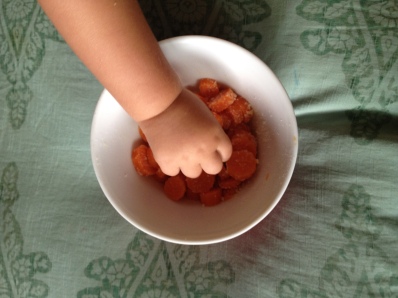There are a lot of opinions out there on how- and when- meat should be introduced into your baby’s diet. I’m going to share my philosophy, but my intention is not to provide medical advice.
Introducing meat and poultry into your child’s diet has everything to do with iron. There are plenty of articles out there about how even breastfed babies aren’t able to absorb as much iron from breastmilk when they begin eating solid foods because of the way the iron in breastmilk bonds to the proteins in solid food, so red meat is an important first food to make up the difference. However, in all my research, I wasn’t able to find any studies or solid research to prove this.
It is true, though, that baby’s iron stores will begin diminishing around 6 months of age. Some pediatricians will prescribe iron supplements and iron-fortified foods (like cereal, which should not be given prior to 8 or 9 months of age), but this unfortunately has a counter-productive effect. Iron supplements and iron-fortified foods actually interfere with the body’s ability to absorb iron, so baby actually gets even less with supplements.
If you’re still breastfeeding, good news- the iron in breastmilk is extremely bioavailable, with up to 50% being absorbed by your baby’s body. If you’re using formula, your baby absorbs quite a bit less (as low as 10%) so the solid foods you offer are extremely important. Red meat isn’t the only food you can offer your baby that’s high in iron, so if you’re a vegetarian, there are plenty of viable sources of iron available. Be sure to include plenty of these foods, particularly if you are not breastfeeding:
- red meat (beef, lamb)
- poultry (chicken, turkey)
- fish
- tofu
- legumes
- peas
- avocados
- dark leafy vegetables (kale, spinach, chard)
- broccoli
- ancient grains (amaranth, quinoa, millet)
- sweet potatoes and yams
I suggest introducing chicken first, then red meat, then fish. But regardless of the when, the how remains the same:
Tenderize It
You need to break down some of the tough-to-digest fibers in meat so that baby’s body can digest it easily. One way to do this is to place the cut of meat between two sheets of wax paper and really pound it, down to a ¼-½ inch thickness. Or, try marinating the meat first. Many cultures marinate their meat in milk or yogurt (the lactic acid in the milk helps tenderize the meat) before cooking. Marinating or simmering in apple juice is another great option if baby has issues with dairy.
Don’t Dry It Out
If you’re cooking meat for a baby, the method you use is probably the most important factor. You’ve got to keep the meat from drying out- that means no sautéing, grilling, or frying. Stew is an ideal way to cook meat, and it’s one of the easiest methods for you. You could also put a cut of meat and some veggies in tin foil, wrap it tightly, and bake it- the steam will stay inside the foil packet and keep the meat moist. Simmering in broth is another easy (if not boring) way to cook meat. If you’re good at making really tender roast chicken or pot roast (I’m not), make one for the whole family and just set some aside for baby.
Puree It
Multiple studies have shown that the iron in meat is more readily absorbed by your baby’s body when it’s pureed to a very fine meal. And, if your baby is relatively new to solid foods, they’ll prefer a thinner, smoother consistency anyway. My daughter, at 16 months old and equipped with as many teeth, still won’t eat red meat by itself and is suspicious even when I blend it roughly with veggies. If you’ve cooked your meat really well, it should blend up fairly easily in a food processor. The key is to blend a little bit at a time with enough liquid to get it really smooth.
Keep It Real
Don’t even think about giving your baby hot dogs or bologna or salami or any meat that’s been processed. Seriously.
Introduce It With Known Foods
If this is baby’s first time eating poultry, meat, or fish, introduce it mixed with other foods you already know he likes and digests easily. Need a few ideas?
- Beef stew with barley, peas, and carrots
- Chicken with brown rice and yams
- Lamb with rosemary mashed potatoes
- Wild-caught salmon with quinoa and asparagus
- Turkey with white beans and cranberry sauce
- Ground beef with spaghetti, tomato sauce, and parmesan
- Wild-caught tilapia with spinach and roasted pears
When introducing new foods always remember to follow The 3-Day Rule.
We don’t eat meat very often, so I haven’t posted any meat-based recipes yet. But I hope to get a few posted soon! In the meantime… Any questions on how and when to introduce meat and poultry into your baby’s diet?
